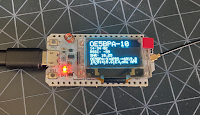LoRa APRS on 70 cm - part 1: Informations
The LoRa® modulation is a spread-spectrum technique that uses wideband linear frequency modulated pulses to encode information, whose frequency increases or decreases over a certain amount of time.
As with other spread-spectrum modulation techniques, LoRa® uses the entire channel bandwidth to broadcast a signal, making it robust to channel noise. In addition, because LoRa® modulation uses a broad band of the spectrum, it is also resistant to long term relative frequency error, multi-path fading and Doppler effects.
LoRa ARPS on spectrum with 433 MHz wireless sensors in the city
Some useful websides:
LoRa APRS Gateway on Raspberry PI
- You can run also 2m APRS (RTL-SDR)
- Web based SDR (RTL-SDR)
LoRa APRS Gateway on TTGO board
- Smaller power consumption compare to raspberry PI
- Cheaper
My instalations:
OK2ZAW-1 & OK2ZAW-5
- Raspberry PI with LoRa APRS, RTL-SDR for 2m APRS and RTL-SDR for OpenWeb RX
- Wideband LNA + FM notch filter + 3-way CATV splitter. Lora has 433MHz BPF.
- Antenna is dualband X-30
Coverage OK2ZAW-1 December 2020
OK2ZAW-2 & OK2ZAW-4 Cottage
- Raspberry PI with LoRa APRS and RTL-SDR for 2m APRS.
- Wideband LNA + 2-way CATV splitter. Lora has 433MHz BPF.
- Antenna is dualband X-30
Coverage OK2ZAW-2 December 2020
- Unter first testing - missing MPPT solar charger
- TTGO Lora32
- 4 Ah / 12 V Pb aku + 10 W solar panel - 0,035 A @ 13 V
- QTH: Koruna JO80fg 1100m asl, antenna 2m above gnd
- Antenna is dualband X-30






















No comments:
Post a Comment